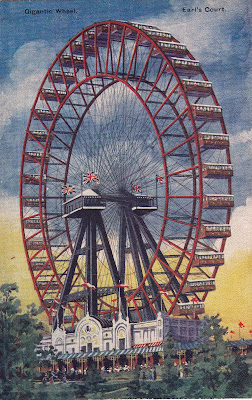Brief History of Picture Postcards
“Nothing
is more nostalgic than the modernity of the past”
1869 The
Postal Service of Austro-Hungary issued pre paid cards that could be sent on
their own without an envelope at half the price. They lacked however any
pictorial matter.
1873 The
USA followed with their own official postal cards, basically unwrapped mail.
Germany alone started to develop pictorial cards, allowing space under the
picture for a short message, and “Gruss Aus”,i.e.“Greetings From”.
1893 America
introduced the first picture postcard for Chicago’s World’s Columbian Exposition. World’s Fairs were to become
great generators of postcards sent, and collected, by their visitors as
souvenirs. Hold-to-Light cards were particularly popular at the Paris Universal
Expo in 1900.
1894 In
England the Post Office introduced rather unpopular square Court cards, 4.75
inches by 3.5 inches with a small picture on one side.
1899 First
International Illustrated Post card Exhibition in Venice. A Signore Besso had a
collection of 6,000 cards
1899 The
Post Office introduced the standard size allowed by the Universal Postal Union;
5.5 inches by 3.5 inches { The Universal standard size is now 6 inches by 4
inches}. The picture on one side
had to include space for a message as the other side was exclusively for the
address.
1899
Raphael Tuck & Sons issued the first
colour postcard featuring a painting of the Tower of London.
1902 The
Divided Back was introduced by the Post Office which allowed the address and message
to be written on the one side. France adopted this new format in1904 and America
followed suite in 1907.
1902-1915 The
Golden Age of postcards, they became an essential part of everyday life, the
new rapid communication media. Cheap and simple they joined word and image,
with up to 7 deliveries a day. They were the text message and camera phone of
their day, and became as ubiquitous as an e-mail today
An estimated 350 million cards were sent in 1904, rising to
700 million in 1908 and 833 million in 1909. In 1903 a billion postcards passed
through the German postal system.
1918 -1939 The
telephone slowly replaced the postcard as a means of quick communication.
Postcards became more a proof of travel, a “wish you were here” plus a “how are
you” and “the cross shows were we are staying”. The growth of trains and
holidays encouraged this growth. Saucy naughty cards developed, Donald McGill
in UK [12,000 cards] and Bamforth in the USA with up to 16 million a year.
White borders became popular 1915-1930, and
linen backed cards from 1930 -1950.
1945-1970 The
rapid growth in holiday entitlement and overseas travel resulted in a second golden age, this
time of holiday cards of the “ Greetings from Margate” style.
1970- on There
has been a gentle decline due to increasing use of camera phones and e-mail.






















































